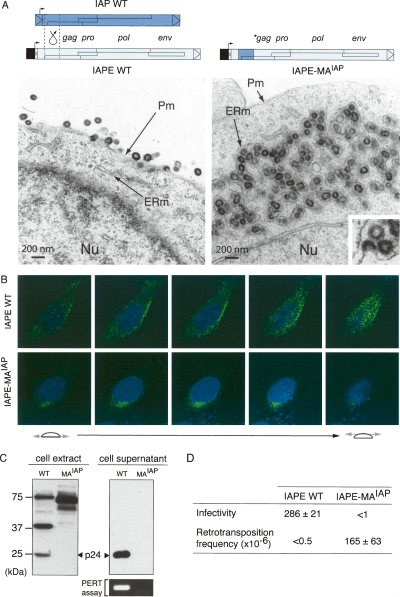Figure 6.
Structural and functional IAPE to IAP transition. (A) Structure of the wild-type and chimeric IAPEs and morphology of associated VLPs. The IAPE-MAIAP element was constructed as illustrated by replacing the IAPE Gag N terminus with that of IAP. Representative low-magnification images of 293T cells transfected with the wild-type IAPE disclose particles budding at the cell membrane (left). No particle can be observed at the level of the ER. Low-magnification images of cells transfected with the chimeric IAPE (right) disclose particles accumulated in the cisternae of the ER, with a high-magnification image of a particle budding into a cisternae (bottom right inset). No particle can be observed at the level of the cell membrane. (B) Immunofluorescence confocal analysis of human HeLa cells transfected with wild-type or chimeric IAPEs, fixed, permeabilized, and stained with the anti-Gag antibody (green). Nuclei are stained with TO-PRO-3 iodide (blue). (C) Western blot analysis of whole-cell lysates or cell supernatants from 293T cells transfected with either the wild-type (WT) or the chimeric IAPE (MAIAP). (Bottom right) Detection of RT activity in the corresponding cell supernatant, using the PERT assay. (D) Functional characterization of wild-type and chimeric IAPE. Infectivity was assayed as in Figure 4 either with the wild-type or the chimeric IAPE (mean values ± SD, n = 3). For the retrotransposition assay, HeLa cells were transfected with the wild-type or chimeric IAPE element in which the neoTNF indicator gene was inserted into the env gene, thus rendered defective (see structures in Supplemental Fig. S2). Retrotransposition frequencies were determined upon G418 selection of the transfected cells, as in Figure 5D (mean values ± SD, n = 3).

